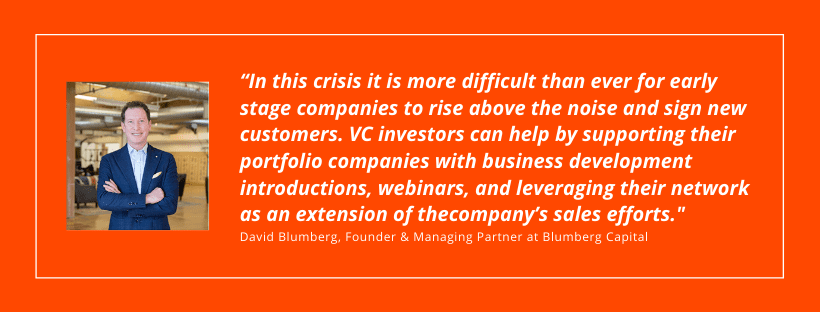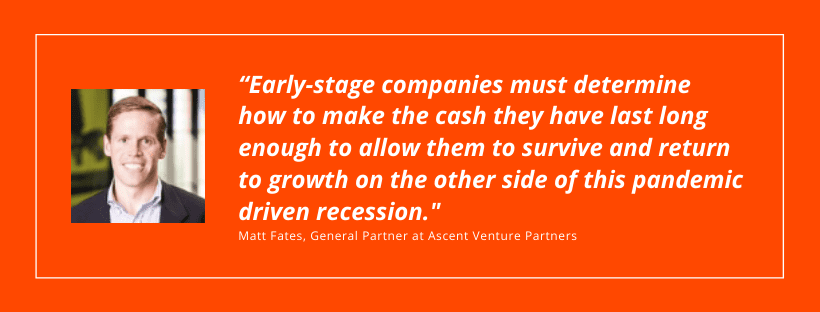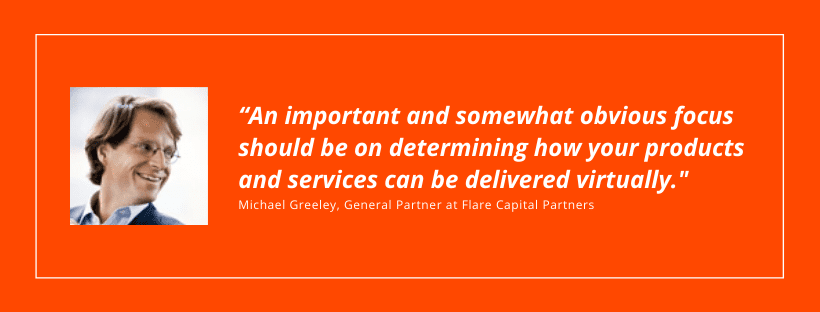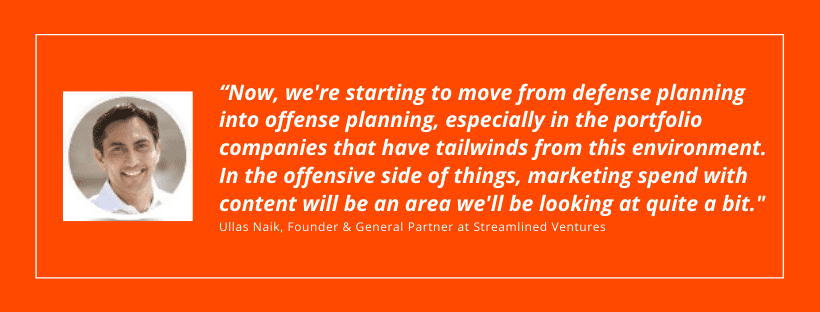Insights with Experts: Leading VCs Assess Current Market Trends and Growth Opportunities

Current economic conditions have caused the VC landscape to shift its focus over the past few months. Industries that were hot six months ago may be swallowed up by emerging technologies that have taken center stage to help fight the pandemic.
That’s why I took some time to sit down with leading venture capitalists to discuss the pulse of the market. Here are the four experts I spoke with:
- David Blumberg, Founder & Managing Partner at Blumberg Capital
- Ullas Naik, Founder & General Partner at Streamlined Ventures
- Matt Fates, General Partner at Ascent Venture Partners
- Michael Greeley, General Partner at Flare Capital Partners
In this Q&A, you’ll learn more about their current priorities and investment opportunities, top challenges for their portfolio companies and advice they have for early-stage brands looking to thrive in a post-COVID world. Here are the topics we discussed:
- How has the current crisis impacted the VC landscape specific to early-stage brands?
- What industries do you and your firm typically look to focus your investments in, and is this changing due to the current pandemic?
- How are startups altering their funding needs due to current climate? Are they resetting expectations?
- Advice for newly funded tech startups; where should you allocate funds during the pandemic?
- Which vertical industry do you predict will come out of this pandemic the strongest?
- What’s the one thing that every startup CEO should feel optimistic about?

How has the current crisis impacted the VC landscape specific to early-stage brands?
Blumberg: The investment climate is typically dominated by the bull or the bear. In this crisis, widespread public fears and media reports have caused the bears to have a strong run. But as venture capitalists, we should remember to focus on the longer term and therefore, Blumberg Capital is as active as ever.
In this crisis it is more difficult than ever for early-stage companies to rise above the noise and sign new customers. VC investors can help by supporting their portfolio companies with business development introductions, webinars, and leveraging their network as an extension of the company’s sales efforts.
VCs and angels should recall that some of the best venture-backed companies have been founded and funded in recessionary times, therefore they should be seeking outstanding entrepreneurs to fund.
Greeley: Trusted brands in healthcare are always important, perhaps more so than other industries. Given the severely cash-constrained environment we are in, investing significantly in traditional brand building may simply not have an adequate ROI in the immediate term.
In B2B models, some of our companies have deepened their customer relationships and generated goodwill by helping their healthcare customers better take care of their patients in the context of COVID-19 with product enhancements and flexibility.
B2C models in healthcare have been tricky to scale, certainly without a lot of investment. Consumer budgets are extremely tight and, more often than not, healthcare products are provided via employee benefit plans or health insurers. As it relates to venture firm brands, the best way to build brand is to invest in great companies as well as providing industry thought leadership.
Naik: They’ve changed on a few dimensions. One is that deal flow has decreased, which makes sense, and the reason is most seed-stage and even later-stage VCs are generally “open for business” but aren’t really writing too many checks. We’ve continued to just invest at our pace because high-quality investment opportunities keep coming, but my instinct is to want to slow down so we can focus and spend time on our portfolio.
Fates: Stating the obvious, we have rapidly shifted from a market with tail winds to one with head winds. With all the uncertainty, decisions are being pushed off, making new sales very challenging.
For companies that are dependent on growth to survive, this requires a stark shift in expectations. Sadly, in many cases this means not only freezing hiring and elective spending but reducing staff or pay levels. Early-stage companies must determine how to make the cash they have last long enough to allow them to survive and return to growth on the other side of this pandemic-driven recession.
What industries do you and your firm typically look to focus your investments in, and is this changing due to the current pandemic?
Blumberg: At Blumberg Capital, we typically focus our investments across the enterprise B2B realm, including: fintech, enterprise software, data analytics and infrastructure, health tech, cybersecurity, supply chain and mobility. Our investment thesis has not changed and these areas remain highly attractive. In fact, a number of our companies are doing better than ever, particularly in fintech, cybersecurity, health tech and supply chain.
We believe the world will come out of this stronger and that this is the dawn of the era of the virtual enterprise. The silver lining of this crisis is the adoption of promising new technologies including telemedicine, supply chain management, digitization and automation of the white-collar economy.
Greeley: The Flare Capital investment strategy is focused on a number of broad important themes: novel care delivery models, the patient as a consumer, payment reform, infrastructure, and analytics. Even in the face of the pandemic these themes are enduring and will continue to be areas of great innovation and new company formation.
The health crisis has certainly exposed specific areas of opportunity around telehealth, improved supply chain, and better population focused analytics. For instance, with the dramatic increase in unemployment and explosion of the number of people now reliant on Medicaid, healthcare technology holds great promise to manage those populations in a more appropriate manner.
Naik: One of the areas we’re investing in is in what we call “Industry 4.0,” which plays into the trend around bringing manufacturing back to the U.S. On the digital health side, we just invested in a company that’s building a telemedicine platform for pediatrics. I think companies like these are going to have a chance to become very big brands over the next 10 years. Disaster planning tools are another really interesting opportunity that most people are not focused on but I’m really intrigued with because I believe that at some point every university is going to offer a course around pandemic planning.
Aside from those two areas, there are high-quality entrepreneurs driving high-quality businesses all the time, in all environments. And we’re seeing them, but the pace has certainly slowed down a little bit. And obviously valuations have come down, so the same company I might have seen in Q4 might be 25, 30 percent cheaper in terms of the valuations at which we can invest now. So that’s certainly a positive dynamic for us as investors.
Fates: We invest in early growth-stage B2B tech companies, and this will not change because of COVID.
Interested in learning more about marketing strategies for growing B2B brands? Check out our NXT Stage Approach.
How are startups altering their funding needs due to current climate? Are they resetting expectations?
Blumberg: Many startups have postponed raising capital in this downturn because they think the door is shut while, in reality, many doors are still open. This isn’t to say that pricing expectations haven’t changed – they have and will continue to be adjusted or renegotiated during this time.
It’s important for startups to prove their value now and as we emerge into the recovery. We’ve been pleasantly surprised that a number of our portfolio companies are doing so well through this downturn, and it’s because they are leveraging their natural digital advantages of digital innovation based on new technological adoption.
Greeley: Unfortunately, there will be somewhat perilous times over the next three to six months, so being obsessively focused on near-term, value-creating milestones will be essential. Take immediate and possibly dramatic cost reduction steps to extend cash runways as long as possible.
Startups will need to be closely engaged with existing investors and assess their interest and/or capacity to invest additional capital as new investors will be hard to engage with until quarantine restrictions lift. Certain types of customers, like providers, will be somewhat harder to sell to, as they are distracted with the crisis and their financial conditions have been so impaired.
Fates: Yes, all of our portfolio companies have changed posture and expectations. Some dramatically, others more moderately, dependent on their specific industry and situation. Most are assuming raising additional venture capital will be near impossible, so they must preserve cash and find other ways to help cover expenses.
If you were to advise a newly funded tech startup on where to allocate funds during the uncertainty of these next few months, what are the top three or four areas to focus on?
Greeley: An important and somewhat obvious focus should be on determining how your products and service can be delivered virtually. Do not over-design or over-engineer your product offerings. Look to sell aggressively to early adopters to achieve “proof of principal.” Engage with strategic partners who may also be interested in being possible investors in your company which will provide additional runway as well as product validation.
Blumberg: The top four areas for most startups to focus on are: developing better product, automating internal processes and keeping existing customers well served and satisfied, while maintaining employee coordination and morale.
Many early-stage businesses should first do contingency planning to determine their go-forward plans. Then they should implement defensive, stabilization and offensive strategies to grow stronger as the crisis recedes and the recovery accelerates.
Fates: I would suggest brands focus on retaining and selectively growing existing customers, and longer-term product innovation.
Naik: Do the planning exercises right now so that at of the end of Q2 or early Q3 you’re well positioned and ready to step on the gas. We spent the last two months doing intensive planning with a lot of our portfolio companies, and it was all about trying to get them to have 12 months of gross cash burn runway. That became a huge imperative for us. There was a combination of some cost cutting, some cost reduction based upon salary reductions, maybe some headcount reductions (unfortunately), and also creative financing where we might be able to get some loans through a variety of sources as a way to shore up the balance sheet.
Now, we’re starting to move from defense planning into offense planning, especially in the portfolio companies that have tailwinds from this environment. In the offensive side of things, marketing spend with content will be an area we’ll be looking at quite a bit.
Which vertical industry do you predict will come out of this pandemic the strongest?
Blumberg: It’s difficult to choose just one. We predict that FinTech, health tech and supply chain software will face very strong demand as the recovery gains momentum.
These three verticals provide essential services and are able to serve customers anywhere. Telehealth and contactless payments are certain to rise in popularity and demand. Supply chains for global trade are being reconfigured now and for the coming decade.
This is a crisis unlike any other in that governments ordered businesses to shut down across the board for the first time in human history. Our view is that technology is part of the solution and the more digital the business, the more it will thrive.
Greeley: I am biased but think the healthcare technology sector will be even more important post-COVID-19. It is widely understood that on the heels of significant market corrections, terrific vintage investment years follow. Important new companies will be created in this sector to address some of the obvious market needs that we are all now seeing firsthand.
Naik: I think digital health and manufacturing are two industries that will rebound fairly strong from this economic downturn.
Fates: Connectivity/communications. Online engagement applications for customers, employees etc.
Content you might be interested in: “Keeping Pace with Digital Health Transformation Through Integrated Marketing & PR.”
What’s the one thing that every startup CEO should feel optimistic about?
Blumberg: Every CEO should feel optimistic about the fact that we will get through this – together. Humans are adaptable, resilient and innovative. While it might look a little different, the economy is going to rebound. And the lessons learned from this downturn will likely make many businesses more resilient.
Businesses have learned important lessons around how to budget effectively and reduce wasting money on the unnecessary.
Naik: One day at a time, make it through the next 12 months. Survive to thrive, and you’re going to get a chance to thrive in a big way. I think a lot of companies are going to come back from this.
Fates: This too shall pass, and we are a resilient and adaptive society.
Looking for the right marketing framework to guide you through the economic downturn? Download our NXT Stage Startup Kit, “How to Use Creativity to Find Opportunity During a Downturn.”


